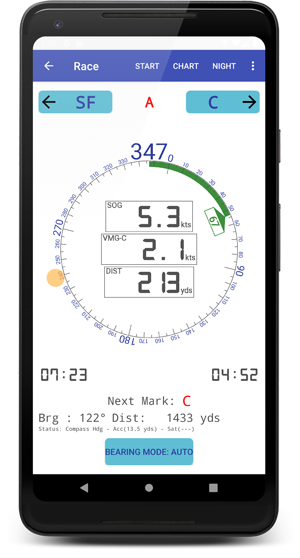RaceTac
For Racers, By Racers
So, What is this 'VMG' about anyway? First, it stands for 'Velocity Made Good'. But you already have your 'SOG' (Speed Over
Ground), so what does VMG give you? Well, VMG is your effective speed toward something, even if you are traveling at an
angle. When sailing, it is pretty common that you are not heading
directly where you want to go. The Math: Technically, VMG is your SOG times the Cosine of the
angle you are sailing off of where you want to go. Meaning your relative
bearing to the wind or a Mark. In the example here, RaceTac is
showing Mark 'A' to be 67 degrees to starboard. And the speed over
ground is 5.3 knots. The Cosine of 67 degrees is about 0.391,
which times 5.3 gives you 2.1 as a VMG. So you are making good 2.1 knots towards the mark. If you remember (or
Google) your trigonometry, you will find that the Cosine of zero
degrees is one. Thus if you are headed straight at your destination (relative bearing is zero),
your VMG is SOG times 1. They are the same. Pretty obvious. The Cosine of 90 degrees is zero. So if you are headed 90 degrees off where
you are trying to go, your VMG is your SOG times 0, which means you are not making ANY way toward where you are going! Pretty obvious if
you think about it, as if a Mark is off your beam, you aren't getting any closer! When you pass 90 degrees, the Cosine becomes negative, and
even though your are still sailing at say 5.3 knots, the Mark is now behind you and your VMG becomes negative! You are sailing AWAY from
the Mark at your VMG. RaceTac shows such a VMG as red.
REMEMBER: If you are using a GPS track as your heading, as RaceTac does unless you are going too slow to detect, it will not always be where your boat is pointing. It will take into account currents and leeway! So it is arguably the better
heading to use. If you are using a compass heading, remember you have to figure currents and leeway! I prefer a GPS heading, and then only have to adjust slightly for changes in current and windage leeway during the leg.
So Many VMGs to Choose From: There are primarily THREE VMGs that are talked about when sailing. VMG to a Mark, commonly called 'VMG on the Course' (VMG-C), which is your effective speed directly towards the mark, 'VMG on the Leg' (VMG-L), which is your effective speed to a line perpendicular to the leg and running through the mark, and VMG to the Wind.
Each has benefits. Since RaceTac does not have wind data from instruments, it gives you a choice of VMG-C and VMG-L which you can switch by tapping the VMG box in the display. VMG-L is going to be very close to VMG to the wind on an upwind or downwind leg, assuming the course is set close to the wind.
VMG-C has the advantage that it shows
your actual progress toward the Mark. Usually, about the time it goes to zero, it's time to tack! The only exception would be how close to the
wind you can point, or a current. The downside is that, unless you are headed direct to the mark, your angle is constantly changing, so the
VMG changes over time. But useful over short periods of time, like 30 to 60 seconds, when playing with trim and angles. On a reaching leg, you generally just look at SOG becausyou are likely sailing right at the mark. VMG-L can be used to judge your effectiveness upwind or downwind, but only on an upwind or downwind leg. VMG to the Wind usually doesn't change unless you get a shift and your angle changes. It can be used to adjust trim at a given angle to the wind, and it is great for that,
but it does not show you that your VMG to the Mark just dropped because you were headed or lifted. So there are pros and cons to all three
VMGs. A much more expensive system than RaceTac, with full instruments, might (but often won't) show all three, which would be ideal for a
dedicated tactician. Most of us just don't have a dedicated tactician who can focus on that many numbers. The skipper surely should not, as
she/he is probably helming too! A simple heads-up display is what they need.Velocity Made Good (VMG) - June 3, 2018
 If you are, GREAT! But likely you
will need to Tack or Jibe to get to a racing Mark. So you are getting there indirectly. You are also never headed directly upwind, and while you might head directly downwind, most boats are a tad
faster a bit off the wind.
If you are, GREAT! But likely you
will need to Tack or Jibe to get to a racing Mark. So you are getting there indirectly. You are also never headed directly upwind, and while you might head directly downwind, most boats are a tad
faster a bit off the wind.